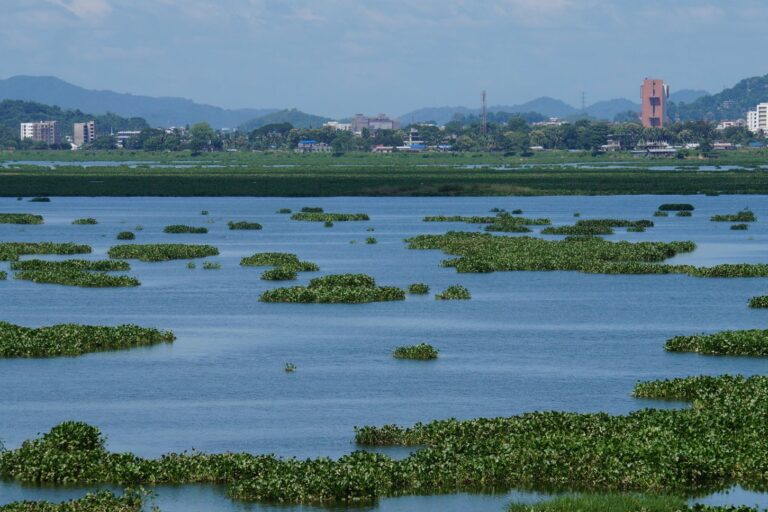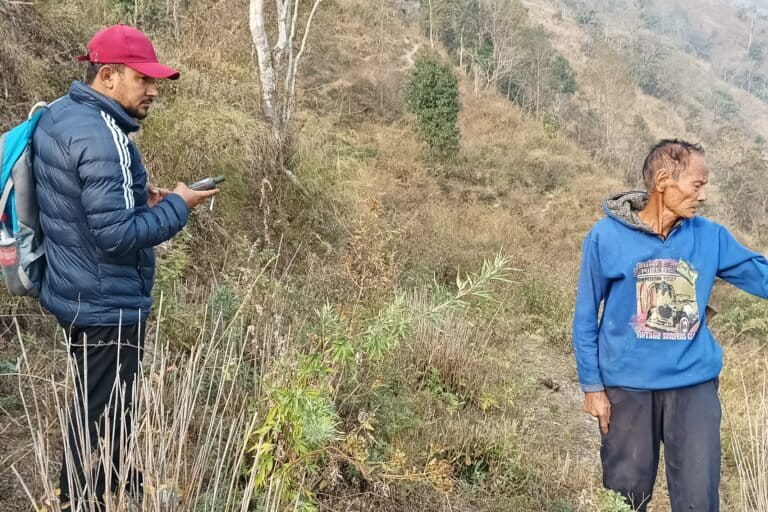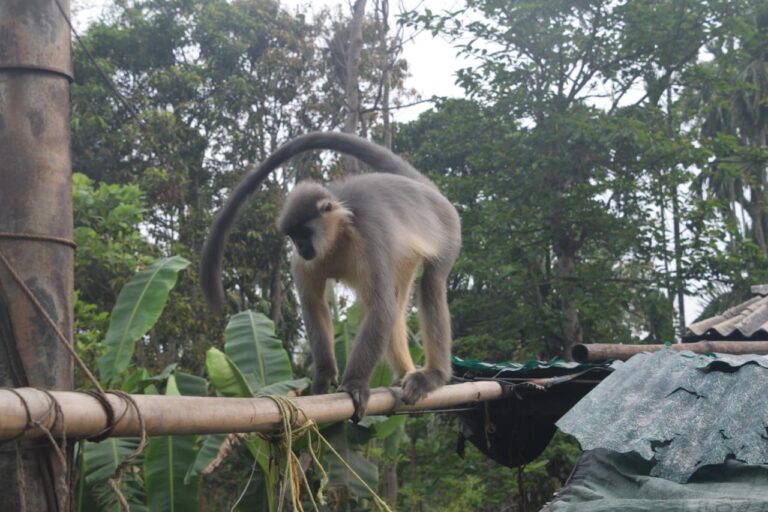- A division bench of the Punjab and Haryana High Court passed a judgement on March 2 to demolish residential and commercial structures built in the Sukhna Lake catchment area, falling in some parts of Chandigarh, Haryana and Punjab.
- Haryana and Punjab have been reprimanded by the state, Delhi and the Supreme courts for permitting illegal constructions and dithering over declaration of eco-sensitive zone outside the boundary of Sukhna WLS and declaration of Sukhna lake as wetland.
- Residents have been protesting against the demolition. Surveys of the sites in the respective states are currently on hold due to the lockdown.
A survey by Chandigarh’s administration, of houses illegally built in catchment area of lake Sukhna, is temporarily on hold with the COVID-19 pandemic and associated lockdown. The survey was being conducted in the wake of an order of Punjab and Haryana High Court on March 2, which directed administrations to remove illegal or unauthorised constructions in the Sukhna catchment area (as delineated by the Survey of India map of Sukhna Catchment Area dated September 21, 2004) that falls in Chandigarh, Punjab and Haryana, within three months. The survey is expected to resume after the pandemic is managed and Punjab and Haryana will also conduct the survey in their respective territories.
In a little over a decade, intense construction, much of it by influential individuals, in the villages of Kaimbwala and Khuda Ali Sher in Chandigarh union territory, parts of Kansal in Punjab and parts of Saketri in Haryana changed the skyscape of the area. These villages are close to Sukhna lake, Sukhna Wildlife Sanctuary (WLS) and part of Sukhna reserve forest as depicted in the catchment area in Survey of India map.
The recent judgement created a panic among the residents, who held a protest in Kansal on March 8. Harjot Singh Oberoi, president of Kansal Residents Protection of Rights Association in Punjab, said, “We have made a joint-action committee under the leadership of Kharar MLA (Member of Legislative Assembly) Kanwar Sandhu and decided to move the Supreme Court. The representative committees of affected people in Haryana and Chandigarh will also take similar action.”

According to some legal experts, who point out to the judgement given by the apex court in TATA Housing Company Ltd (appellant) versus Aalok Jagga case, related to proposal of construction of high-rise building in Sukhna catchment area on November 5 last year, there is little hope of relief from the Supreme Court. In the above case, SC had upheld the verdict of Delhi high court of April 12, 2017, which had disapproved of a 95-meter high and 28-storey building project named ‘Camelot’ in Kansal area of the Sukhna catchment. Around 95 Punjab MLAs were to be recipient of the flats under the project, which was proposed just over a hundred metres from the north and eastern sides of the Sukhna WLS. The complex had 9,788 flats. The court observed that the proposed project would destroy ecologically fragile wildlife and forest in and around Sukhna WLS and cause serious threat to Sukhna Lake. The apex court came down heavily on the Punjab administration while stating in its judgement, “It is clear why the Punjab government has not been able to protect eco-sensitive zone (ESZ) around a wildlife (Sukhna WLS) and has permitted setting up of high-rise building up to 92 meters in the area in question, which is not permissible. The project smacks of arbitrariness on the part of the government, including functionaries. Punjab government’s proposal to confine buffer to 100 metres is not accepted by Ministry of Environment and Forest (MoEF).”
The apex court also made the Survey of India map demarcating the Sukhna catchment, binding on Punjab. The court observed that the map made after thorough aerial survey and ground verification, is the only document available on record identifying and demarcating the catchment of Sukhna Lake. The map was prepared under the direction of Punjab and Haryana high court. While referring to the map, Delhi high court had ordered – which was upheld by the SC – that no housing, commercial or industrial project will take place to the north of the Chandigarh to protect Sukhna Lake and its catchment area. The structures that are to be demolished had come up in the north side, which encapsulate the lake, WLS and reserve forest.
With regard to the appeal made by the counsel for Punjab for a fresh survey of catchment to take stock of the changes that had taken place from 1963 onwards, the superintending surveyor informed that the catchment area cannot be changed or altered unless a natural upheaval takes place, which consequently alters catchment. Manmade intervention cannot change the catchment area as they can only hinder the surface flow of the water, the surveyor informed. The recent judgement also rejected the appeal for fresh survey.
According to Kanwar Sandhu, MLA of Kharar, Punjab, the state government departments have been providing electricity, water connections and charging property tax in these constructions since fiscal year 2013-14. “Nagar panchayat Naya Gaon, municipal committee (MC) formed on October 18, 2006, did not warn people about constructing here. If we endorse Survey of India map 2004, it would put a question mark on the master plan, notified on January 1, 2009,” added Sandhu.
Repeated bans on illegal constructions not followed
Even before the Delhi high court banned all construction activities in the Sukhna catchment area in Camelot project in 2017, the Punjab and Haryana high court too had banned the new constructions in the area in its order issued on March 14, 2011. However, illegal construction after the 2011 continued as court order was not given adequate publicity. Baljinder Kaur, president MC Naya Gaon had expressed her helplessness before the court for not getting adequate assistance from the administration and police in carrying out the demolition.
“Very few structures were demolished in January 2017, but nothing much happened after that. However, we neither approved the map nor provided water/electricity connections of the houses built after March 14, 2011, as per the court order. Now, there are over 500 illegal residential or commercial premises built in the Kansal area alone,” added Kaur.
In the latest order (March 2020), the states have been penalised for permitting the illegal constructions. The bench fined both the states to the tune of Rs 100 crore each as damages for restoration of catchment area of Sukhna Lake. The environment ministry has been entrusted with the task of restoration of Sukhna Lake with the collective amount and Ministry will frame statutory scheme under the Environment Protection Act within three months and complete the restoration work within a year. The Supreme Court bench also directed the chief secretaries of both the states as well as Chandigarh city adviser to set up a high-powered committee to fix accountability for the unauthorised constructions and take stringent action against the erring officials in the matter.
The court also directed Punjab, Haryana and Chandigarh to provide alternative sites in close proximity of Chandigarh to the owners and Rs. 25 lakh to each of whose building maps were approved and who have constructed their buildings in the catchment area.

Declaring eco-sensitive zones outside the boundary of Sukhna WLS
Chandigarh administration had declared 25.9849 sq km area as WLS on March 6 in 1998. The court has now directed the environment ministry to notify at least 1 km area from the boundary of Sukhna WLS as eco-sensitive zone (ESZ) falling in Punjab and Haryana within three months.
Debendra Dalai, chief wildlife warden, Chandigarh, said, “Chandigarh UT has declared an area of 2,594.60 acres, falling within 2 km to 2.75 km outside the boundary of Sukhna WLS on January 18, 2017 as eco-sensitive zone (ESZ).”
Chandigarh is also directed by high court to issue final notification declaring Sukhna Lake as wetland under the Wetland (Conservation and Management) Rules, 2017. Dalai expressed confidence that the task will be completed within the stipulated time.
Punjab and Haryana were also directed to issue necessary notifications for declaring Sukhna falling in their respective areas as wetland within three months from the order to protect fragile ecology and to support the lake eco system.
Rakesh Kumar, additional chief secretary (forest) of Haryana Government said soon a meeting would be convened to deliberate on the further course of action on various issues related to recent judgement of Punjab and Haryana high court. Pankaj Yadav, chief administrator of Haryana Shahri Vikas Pradhikaran (Haryana Urban Development Authority) too reiterated the same stance.
Madhu Sarin, an environmentalist who had planted trees and created check dams to contain soil erosion in Sukhna catchment, said, “We are blessed to have a rich ecosystem comprising a healthy wetland, reserve forest area as well as a wildlife sanctuary. The citizens have equal responsibility in maintaining and enhancing them further because environment is vital for the survival of us in the wake of increasing pollution and other environmental threats such as rising temperature due to climate change.”
Banner image: Sukhna lake. Photo by special arrangement.














